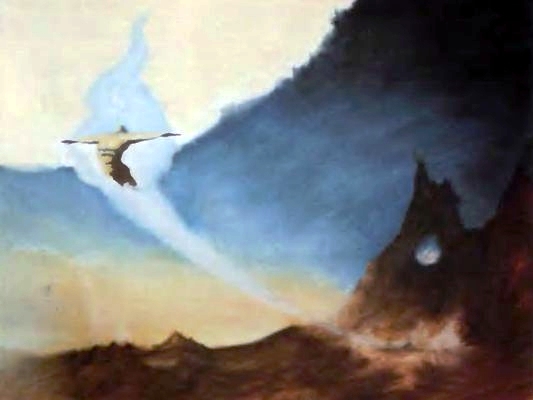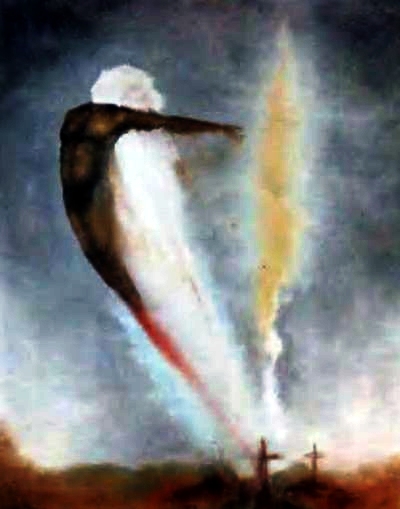![]()
The Words of the Lee Family
|
|
The Words of the Lee Family |

Around June of 1985, during a Principle seminar in Kwang Joo, Dr. Se Won Yoon showed me photographs of two paintings that gave me an unusual feeling -- a feeling I had never gotten from looking at other paintings. I was astonished when Dr. Yoon said that they had been done by Heung Jin Nim. The thematic content was extraordinary and in their expression I saw a touch of profound maturity. Besides marveling at the excellence of their composition and their evocative power, I was amazed when I realized that they represented the spirit of Heung Jin Nim himself.
These two pictures share the same theme, but represent two different stages in the development of that theme.
The first picture shows three crosses on a hill that seems to be covered with red dust or dyed red with blood. The red and black naked body of a man is soaring from the central cross up to the sky. He wears over his face a white veil like thick smoke. Behind him, a strong vertical flash of light seems to be either coming down or going up against the background of a dark sky. We can also see that a long red flame streams down from the feet of the man, connecting him to the central cross. But looking closely, we can see a person hanging on the central cross as well.
What is the meaning of the person on the cross who is connected to the soaring man? The face covered with the veil, the three crosses, the lightning -- all these things are not arbitrarily drawn here. They must have a symbolic meaning.
I do not completely understand the meaning, but I immediately associated the symbols in the painting with such things as Jesus' crucifixion, the inexpressible circumstances under which he died, and his resurrection after three days. The person soaring from the cross could represent the spiritual body of Heung Jin Nim. But what do the other two crosses mean? Do they represent the two men crucified with Jesus? Or do they symbolize the history of suffering which the family of True Parents has continually faced?
Looking at this picture, we cannot help feeling a brokenhearted sorrow and gloominess; we are seeing Father's life course with its many terrible hardships.
But the feeling of the second picture is completely different. First of all, we can see that the soaring body has entered another space far beyond the earth.
The figure's arms are outstretched firmly and gloriously like a bird's. The chin is pulled upward towards the sky. The strong, muscular belly and chest evoke the curved line of a bow. Because of all this, the soaring man, reflecting the blazing light, looks much more beautiful and yet more mysterious than the man in the first painting.
A blue flame burns around the whole body, which has just soared up from the earth across the canvas like a rocket leaving its launching pad. White hot flames as from a torch look as if they were burning away the sin and dirtiness of the world.

This painting does not have the darkness of the first. It shows us a glorified resurrection and imparts a more holy feeling. We cannot know the exact meaning of the symbols of the earth, the mountain, and the shining white heaven, but they seem to evoke the essence of resurrection. We can see in this picture a victor's glory.
I will not comment here on Heung Jin Nim's mission in life nor on the meaning of his Seunghwa. We can understand these things from Father's speeches and studying the life of Heung Jin Nim himself. But in these paintings events are represented that had been foreseen and put into artistic form by Heung Jin Nim long before the real events took place.
Heung Jin Nim's passing must never be understood as a surprising event or the miserable result of an accident. Dr. Yoon expressed to me that he felt Heung Jin Nim knew through inspiration that he would die young, and that he had the divine mission of representing the True Parents both on earth and in heaven.
If this is so, did Father not know all about the events in store for his son? Father must have known about the coming death of his son, but he did not try to prevent it out of selfish love. His heart must have been the same as Abraham's heart when he sacrificed Isaac, or Jesus' heart when he chose to go the way of the cross himself.
We can imagine that, if Abraham hadn't had a son like Isaac, Abraham would not have had anything to do with the history of Israel, or that, if Jesus had had another Jesus who was willing to die for him, he might have been able to have the bitter cup taken from him.
Since I have seen Heung Jin Nim's pictures, I have not been able to forget that a genius in painting has passed away, unknown to the people of the world, and that I have had the chance to be a witness for him because I have glimpsed his genius.
I feel that the greatness of these paintings does not show itself when we view them merely with our conscious mind; rather, their greatness comes out when we try to imagine that they were painted while Heung Jin Nim was in a state of super-consciousness. This may not be difficult to understand if we think of automatic writing.
Up until now in my life, I myself have never been able to foresee or imagine the future world. I have never even thought of it. Who among the great painters of the world has been able to depict the future? Van Gogh had a premonition of his death and drew a picture entitled "Wheat Fields with Crows" Right before his death in Tahiti Gauguin painted a picture entitled "Where Do We Come From? What Are We? Where Are We Going?" Monet painted a lonely pine tree standing against the sea as a background. Joong Sup Lee of Korea also painted a crow flying at night. But all these painters could not really express the solemn majesty of the panorama of their lives. They felt a premonition of their deaths, but they were all afraid of death. They could not go beyond their doubt and fear.
With free touches of his brush, Heung Jin Nim has painted -- in a state of ultra- consciousness and with the capability of foreknowledge -- his own life course, as if he were watching the unfolding of things to come.
He died at the age of 18, but his works of art will live forever on the earth and within the hearts of us all.